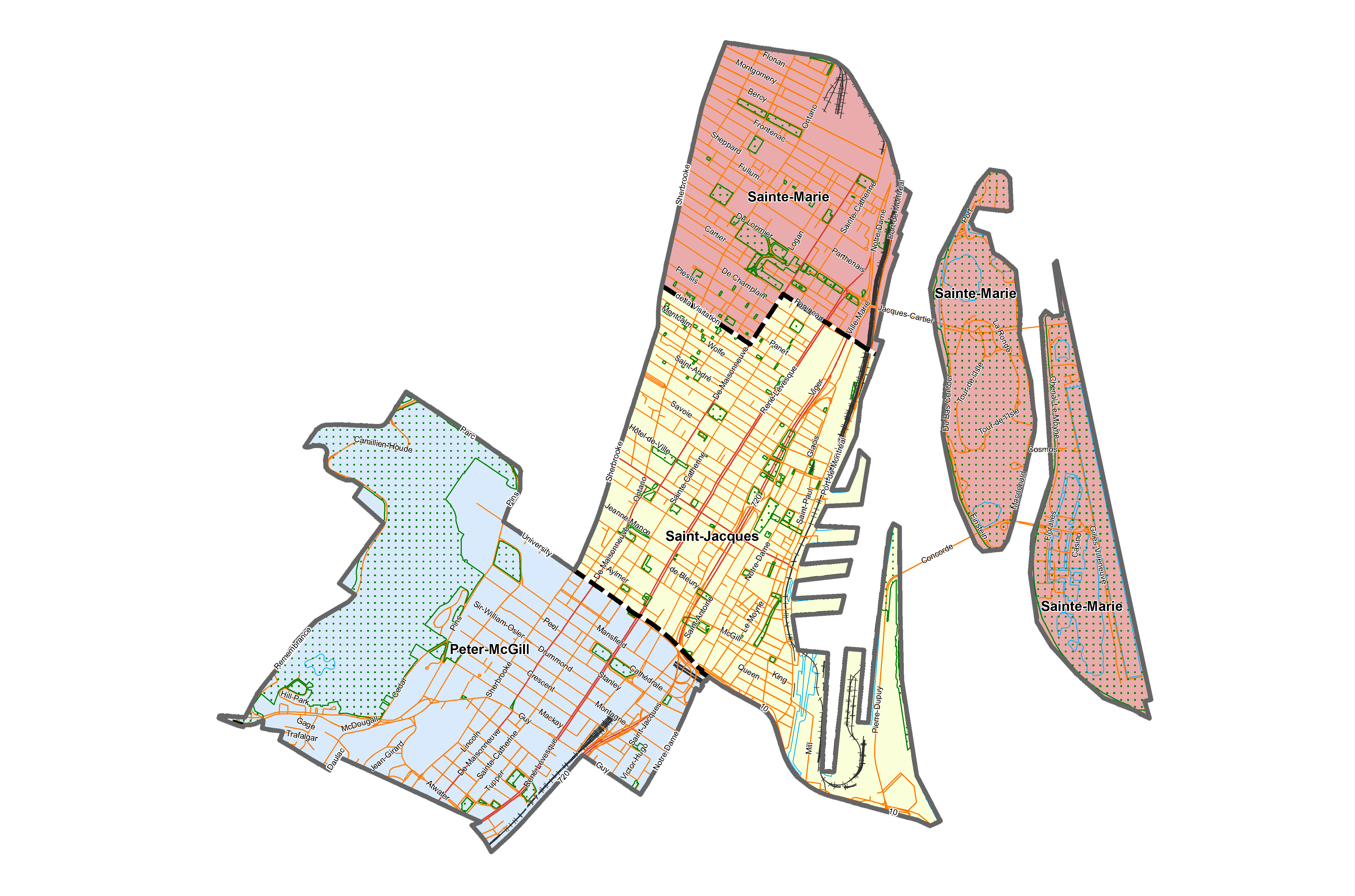
Although centuries have passed since Montréal was founded, the city still bears the imprint of those who built it. As one might imagine, Ville-Marie’s history is inextricably linked to that of the city itself. For nearly 200 years, all of Montréal was contained within the area of the present day borough, until industrialization and urbanization began to push out the traditional boundaries of the city (established in 1792 at a radius of two kilometers from the fortifications).
FROM VILLE-MARIE TO THE BRITISH CONQUEST
Here, like elsewhere in North America, civilization began with an Aboriginal presence. Archaeological research suggests that there were permanent settlements in the area dating back 2,500 to 3,000 years. Samuel de Champlain deserves credit for noticing a small strip of waterfront land he would soon christen Place Royale (today Pointe-à-Callière). Some 30 years later, Paul de Chomedey, Sieur de Maisonneuve, Jeanne Mance and the other members of the Société de Notre-Dame de Montréal founded Ville-Marie.
Initially managed by De Maisonneuve and the religious society that employed him, the small town passed into the hands of the Sulpicians in 1663. The Sulpicians were responsible for organizing the territory, and divided the island they had acquired into seigniorial holdings. More importantly, they laid out the first network of roads in the city itself (1672), including the two main axes, Rue Saint-Paul and Rue Notre Dame, which remain to this today.
The Great Peace of Montreal, signed in 1701, put an end to ongoing warfare with the Iroquois nations and ushered in a golden era for Montréal, which became the focal point of an empire that extended all the way to the Gulf of Mexico. Ville-Marie (which became Montréal early in the 18th century) began to grow. The stone fortification walls, built between 1717 and 1738, would soon represent an obstacle to property development, which overflowed into the surrounding countryside. The first suburbs sprung up and formed the basis of the present-day borough.
On September 8, 1760, Governor Vaudreuil surrendered to the three English armies that had arrived at Montréal, and France’s presence in mainland North America was soon to come to an end.
THE BRITISH CONQUEST TO THE INDUSTRIAL AGE
The British Conquest was a milestone in Québec’s history, not just because it marked the passage of colony domination from one great power to another. It also started and shaped the gradual transition that would bring New France into the industrial age. While some aspects of the socio-economic landscape took sharp turn insofar as control over businesses affairs passed into the hands of recent English and Scottish settlers (like James McGill and Simon McTavish, for example), the focus remained the same: Montréal’s financial welfare still depended on the fur trade. The emergence of a service sector, especially shipbuilding and timber traffic, soon gave the city new life that was merely underscored by the nascent industrial revolution. The opening of the Lachine Canal in 1825 and the Port of Montréal in 1830 laid the foundation for an infrastructure framework that supported a burst of industrialization in the city.
The period from 1760 to the mid-19th century was also marked by the appearance of ethnic tensions that remained until the aspirations of the Quiet Revolution came to fruition. In that troubled climate, Montréal grew to reign as Canada’s largest city for 150 years (until 1976). The road infrastructure gradually took shape as the city adjusted to meet the needs of its growing population.
From a heritage standpoint, the forces that would determine the architectural practices of the industrial age in Canada were already at work, and the Victorian style began to assert itself in Montréal’s religious buildings, such as the neo-Gothic Notre-Dame Basilica (1824-1829).
INDUSTRIAL AGE
The industrial revolution in Montréal spanned an entire century during which the city gradually begins to spill out beyond the territory of the present-day borough of Ville-Marie into its agricultural surroundings.
To a large extent, the face of Montréal also began to take on a more familiar form, with the appearance of the duplex. The Great Fire of the summer of 1852 burnt down many homes in what is today the district of Saint-Jacques, which had to be rebuilt. Standardization was a way to cut costs, and the classic two-storey dwelling became the norm. Vestiges of this residential model with the promise of a bright future can still be seen today in the quadrangle from Sherbrooke to René-Lévesque between Amherst and Papineau.
MONTREAL AND THE 20TH CENTURY
At the end of the Second World War, the city of Montreal began its shift toward the modern age and the gradual shaping of the urban environment that we know today. As always, Ville-Marie set the tone for change. The start of construction of what would become the underground city began in 1958 with the building of Place Ville-Marie (inaugurated in 1962). But it was through the commissioning of the first segments of Montreal’s metro system in the fall of 1966 that the borough really brought the city into the 20th century.
The 21st century is therefore the time for the borough to reaffirm its place in the modern world of Montréal and of Québec as a whole.
Source: Extracts from the City of Montreal




